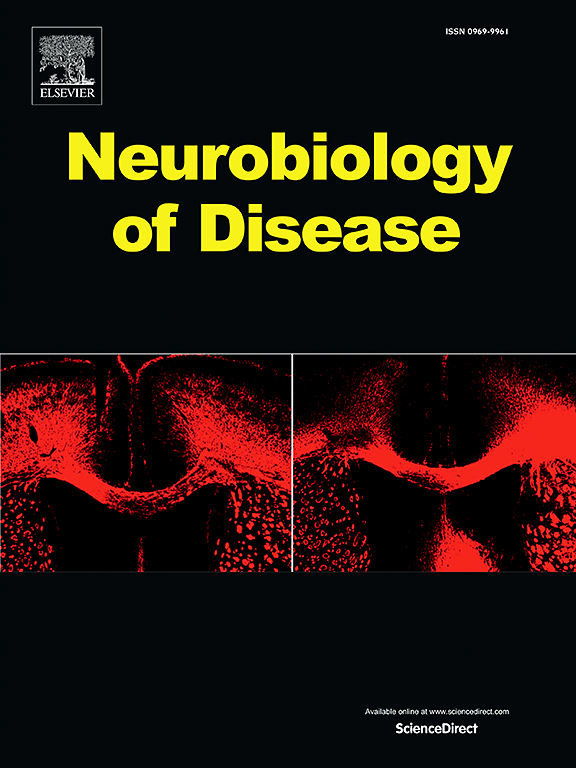Atp7a deficiency induces axonal and myelin developmental defects in zebrafish via ferroptosis
IF 5.6
2区 医学
Q1 NEUROSCIENCES
引用次数: 0
Abstract
ATP7A genetic mutations lead to Menkes disease (MD), a hereditary neurodegenerative disorder develops significant metabolic abnormalities including copper deficiency and hypomyelination, and even death before 3 years old. However, the underlying mechanisms remain poorly understood. In this study, a dysfunction in axons as evidenced by the shortened axons, reduced branching in each axon, thinner spinal myelin sheaths, and a significant decrease in neuronal membrane potential, was manifested in the central nervous system (CNS) of atp7a−/− larvae. Atp7a is indispensable for the axonal survival in a cell-autonomous manner by fine-tuning copper homeostasis. The transcriptomics analysis identified a significant enrichment of ferroptosis among the differentially expressed genes (DEGs). Iron overload, GPX4 degradation, and lipid peroxidation, the fundamental characteristics of ferroptosis, were evident during atp7a ablation. More importantly, administration of ferroptosis inhibitor Fer-1 or iron chelator DFO, substantially suppressed ferroptosis and largely ameliorated axonal and myelin defects in atp7a−/− larvae. Whereas, larvae exposed to ferroptosis inducer RSL3, and engineered larvae developing ferroptosis, phenocopied the myelin and axonal extension defects observed in atp7a−/− mutants. Taken together, this study highlights the critical importance of atp7a in supporting axonal and myelin development during zebrafish embryogenesis by tightly restraining ferroptosis. This study will shed some light on the theoretical basis and therapeutic targets underlying ATP7A dysfunction induced neurodegenerative diseases.
Atp7a缺乏通过铁下垂诱导斑马鱼轴突和髓鞘发育缺陷。
ATP7A基因突变导致Menkes病(MD),一种遗传性神经退行性疾病,发生显著的代谢异常,包括铜缺乏和髓鞘退化,甚至在3 岁之前死亡。然而,潜在的机制仍然知之甚少。在本研究中,atp7a-/-幼虫中枢神经系统(CNS)表现出轴突缩短、各轴突分支减少、脊髓髓鞘变薄、神经元膜电位显著降低等轴突功能障碍。Atp7a通过微调铜稳态在细胞自主方式下的轴突存活是必不可少的。转录组学分析发现,在差异表达基因(DEGs)中,铁下垂显著富集。铁超载、GPX4降解和脂质过氧化是铁下垂的基本特征,在atp7a消融过程中表现明显。更重要的是,给药铁下垂抑制剂Fer-1或铁螯合剂DFO,可以显著抑制铁下垂,并在很大程度上改善atp7a-/-幼虫的轴突和髓鞘缺陷。然而,暴露于铁下垂诱导剂RSL3的幼虫和发生铁下垂的工程幼虫,在atp7a-/-突变体中观察到髓鞘和轴突延伸缺陷。综上所述,本研究强调了atp7a通过严格抑制铁下垂在斑马鱼胚胎发生过程中支持轴突和髓鞘发育的关键重要性。本研究将揭示ATP7A功能障碍诱导神经退行性疾病的理论基础和治疗靶点。
本文章由计算机程序翻译,如有差异,请以英文原文为准。
求助全文
约1分钟内获得全文
求助全文
来源期刊

Neurobiology of Disease
医学-神经科学
CiteScore
11.20
自引率
3.30%
发文量
270
审稿时长
76 days
期刊介绍:
Neurobiology of Disease is a major international journal at the interface between basic and clinical neuroscience. The journal provides a forum for the publication of top quality research papers on: molecular and cellular definitions of disease mechanisms, the neural systems and underpinning behavioral disorders, the genetics of inherited neurological and psychiatric diseases, nervous system aging, and findings relevant to the development of new therapies.
 求助内容:
求助内容: 应助结果提醒方式:
应助结果提醒方式:


